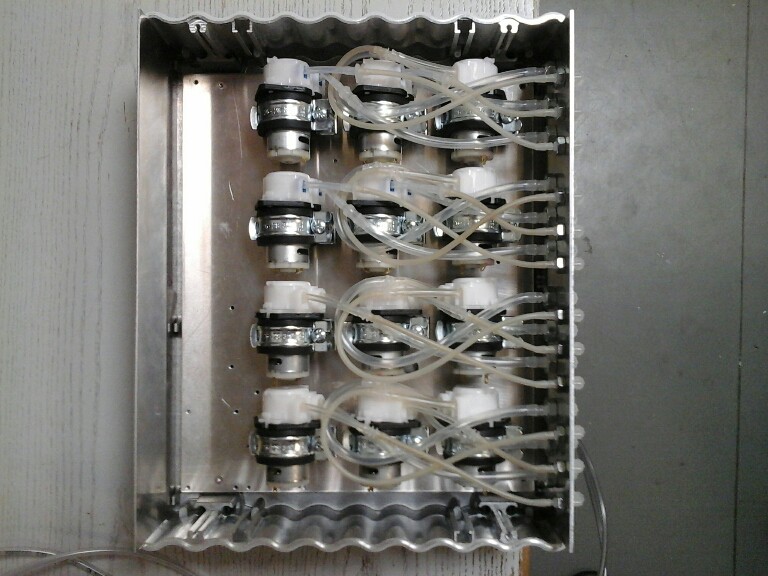Develop once, deploy many?
Peristaltic pumps shine in a few aspects:
- self-priming
- number of rotations correlates to transported volume = no imminent need for flow metering / gauging
- self-sealing and normally-closed operation
- medium and pump are separated
- no sliding surfaces subject to the medium
but then there's basically the rather sketchy construction unless one breaks out the bearings, spacers and proper geometry.
If you're into building your own peristaltic pumps or haven't seen the ugly details, this video might be helpful.
In the post below however we'll be discussing cheap peristaltic pumps from our favourite Chinese e-commerce platform. These pumps don't have a rotor attached to the shaft of the motor. instead, a small brushed motor has a long shaft sticking right into the pump head while three bare plastic rollers are friction driven by the smooth shaft, achieving both a compact design and gearing reduction at the expense of long-term reliability and resilience. Two out of 18 pumps came with collapsed tubing sticking to itself but were subsequently reanimated. One arrived shattered to bits. I guess that's where the term "drop shipping" applies.
Many Pumps
Using many peristaltic pumps surely has its advantages - they are somewhat proven in the field of automated plant watering systems, they're off the shelf parts which can be bought as original parts and replacements from many sources and they interface easily with the rest of the setup in terms of dimenions, tube sizes and voltage / current ratings (e.g. 12V 0.3A).
So let's do that and figure out where the catch really is.

Obviously the unit shown isn't finished and it isn't finished as of this writing. While we now have an MCP23017 + ULN2003 driver board along with a boost converter to run it offa 5V supply it's hard to ignore the sheer amount of stuff that goes into building one of these pump station assemblies. Each pump is routed to the rear panel so the assembly can also be put to use for mixing fertilizer or pH buffer reagents when moving to hydroponics and related.
It's a bit heavy but other than that it should do the business. It certainly is bulky and will not be as reliable in other orientations, e.g. when stood upright or on the sides so the tubing will hang down and maybe kink. In its natural horizontal orientation it just takes up 35 x 30 cm² of shelf real estate.
Let's talk about cost.
In terms of cost this certainly is the most expensive way to water twelve plants, not accounting for uncertainties in the market of chinese parts. Maybe the pumps will cost twice as much in the future, making an array of valves the cheaper option.
Procuring bags of panel mount and straight fittings also adds to the overall joy.
Here's a rough BOM:
- 1 enclosure with base plate, drilled and slotted front and back plates
- 12 peristaltic pumps
- 12 pipe clamps with damping
- 12 M8 washers
- 12 ISO 7380-2 M8x8 Socket Flanged Button Screw
- 24 straight barbed fittings 2.4mm / 3.8mm
- 12 90° barbed fittings 2.4mm / 2.4mm
- 12 M6 nuts (plastic, steel) for the 2.4mm fittings
- 12 90° barbed fittings 3.8mm / 3.8mm
- 12 M8 nuts (plastic, steel) for the 3.8mm fittings
- 10 barbed tee fittings 3.8mm to parallel the suction sides
- 2m silicone tube 2/3 or 2/4mm ID/OD
- 5m silicone tube 3/5mm or 4/6 mm ID/OD
- control and indicator electronics
The 40-50 holes with various diameters don't layout, drill and countersink themselves either.
Let's call this piece of engineering "lab equipment".
 helge
helge
Discussions
Become a Hackaday.io Member
Create an account to leave a comment. Already have an account? Log In.